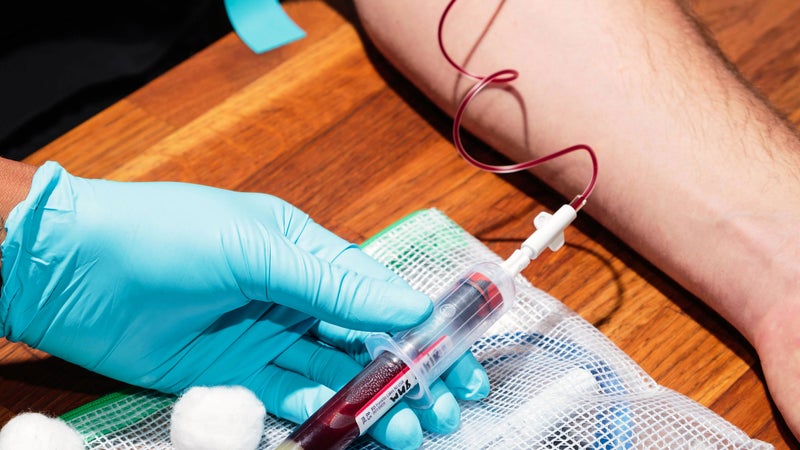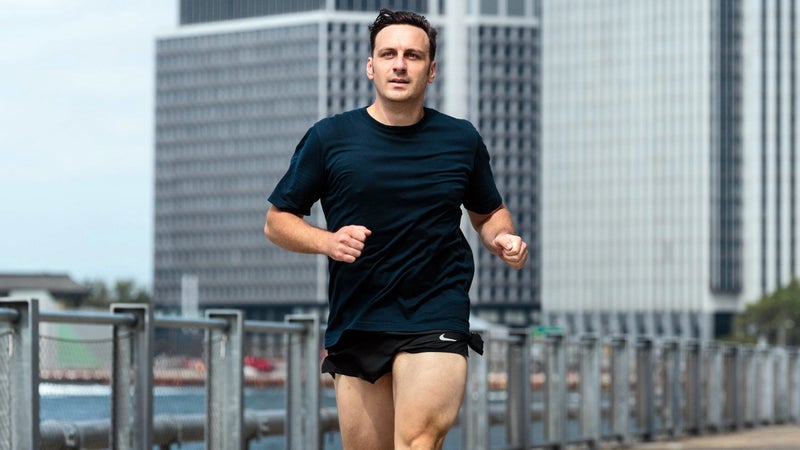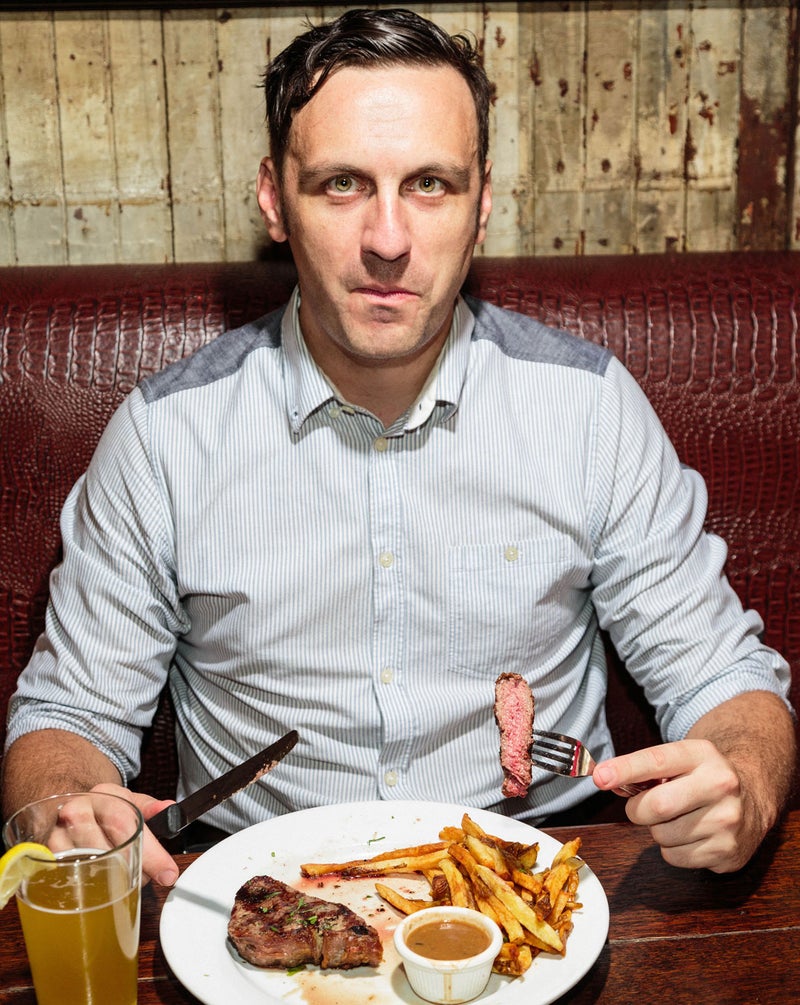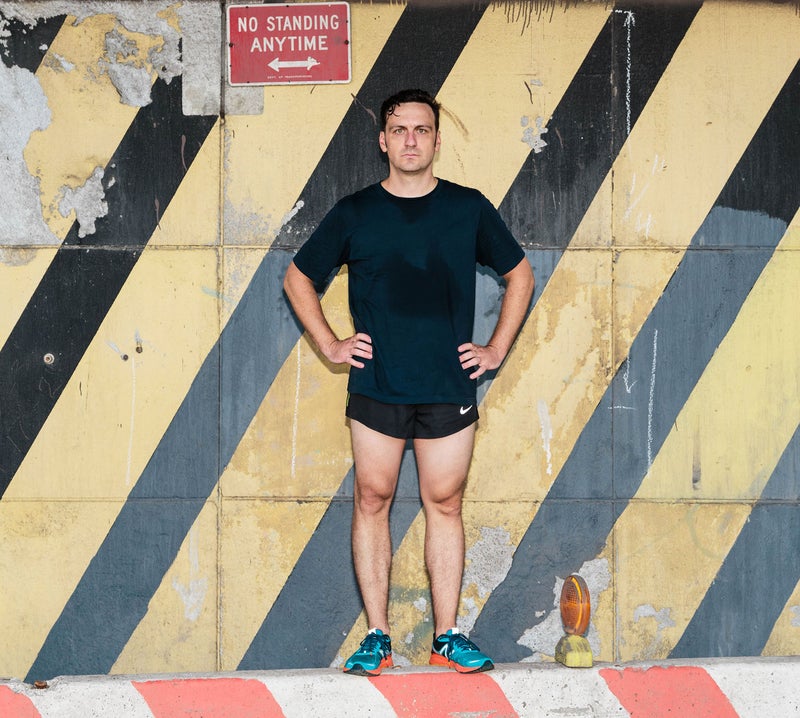Know Thyself
Don’t let the Theranos saga fool you: we’ve entered a new era of self-quantification, in which on-demand blood testing is sold as the easy way to fine-tune your training and nutrition. Can an algorithm really replace your coach?
New perk: Easily find new routes and hidden gems, upcoming running events, and more near you. Your weekly Local Running Newsletter has everything you need to lace up! .
The bloodletting began at my kitchen table.
At 8 a.m., a nurse named Kristy waved an infrared thermometer over my forehead and checked my pulse and blood pressure. Then she slipped on a pair of gloves, rubbed alcohol on the inside of my arm, and guided a 23-gauge needle into my vein. The needle was short and appeared to be wearing a pair of plastic butterfly wings—which was cute and all, but as dark red liquid curled down the attached tube and burbled into a vial, I felt a rush of wooziness.
For reasons I’ll soon explain, my goal was to experience firsthand the new wave of blood tests that claim to optimize athletic performance, improve overall well-being, and increase lifespan. Diagnostic testing is a $75-billion-a-year industry, but it’s one that traditionally was used to diagnose disease. That’s changing, and over the past five years, the wellness-oriented order-it-yourself market has expanded nearly tenfold, to $131 million in 2015, with vast implications for athletes. In many states, it’s now possible to walk into a strip-mall clinic and measure your levels of sex-hormone-binding globulin, believed to be an indicator of overtraining.
Or you can request a house call, which in my case tacked $80 onto my $299 blood panel. Kristy worked part-time for a Manhattan startup that dispatches nurses, and she filled four vials in less than 15 minutes. Afterward, I sat down to work, and she went to her office, spun my blood down in a centrifuge, and packed off the serum to a clinical lab in Boston. The measurements then went to InsideTracker, a Web-based blood-analysis service, which compiled 20 biomarkers, or signs of biological health, into 20 colorful pie charts. These tools, according to the e-mails I soon began receiving, would put me “in the driver’s seat,” and armed with all my new data, I’d be hurtling down the road “toward greater vitality.”
I’m hardly a paragon of athleticism. I have what might charitably be described as cubicle bod.
At this point, I should disclose that I’m hardly a paragon of athleticism. I have what might charitably be described as cubicle bod, and the idea of measuring biomarkers had never crossed my mind until my editor called on a Friday in late May. I was sitting at my desk drinking a can of Centennial IPA. I’d eaten a package of instant ramen for lunch and, before that, slurped down some yogurt, oatmeal, and four fiber pills for breakfast. My phone informed me that I’d walked about 557 steps that morning and run either one mile (according to an app called ) or 1.36 miles (according to ). I’m not grossly out of shape, but I’ve gained about 20 pounds over the past three years. Perhaps it was stress. Drinking a few pints of carbs every week hasn’t helped.
Could frequent blood testing encourage me to lose weight, change my habits, and live a better life? There was only one way to find out.
For years, blood draws worked like this: if you were worried about low iron levels from training at altitude or overdue for routine cholesterol testing, you had to get an appointment with a doctor, which could take two or three weeks, only to have your physician order a panel you knew you needed. Laws in 20 states prohibited patients from seeing their own test results without a doctor’s permission until 2014, when the Department of Health and Human Services revised the rules governing diagnostic labs, granting patients across the country full access to their data. (In several states, regulations designed to prevent healthy people from misinterpreting their results still require physicians to order the lab work.)
As we entered the Era of Quantified Self, blood draws became a popular new tool to track fitness and health. Startups claimed to measure three times as many biomarkers as the panels doctors typically ordered during a physical. Salespeople pitched the services as fully customizable: these tests could unlock the valuable information stored in your blood, enabling you to tweak your diet or personalize training. If doctors once proved reluctant to extract performance-based insights from panels (aside from, say, ruling out serious illness as the cause of fatigue), athletes could now access actionable results via e-mail.
So began the blood-analysis boom. , a Silicon Valley startup, climbed to a $9 billion valuation on the promise of less invasive testing before faltering under regulatory scrutiny. , a service offered by Quest Diagnostics, one of two major companies that dominate lab testing, partnered with the New York Giants to reduce injuries and improve performance. teamed up with Google and Square to use blood analysis to increase employee productivity.
Then, in 2015, introduced InnerAge, a metric that combines self-reported activity and diet information with five key biomarkers—glucose, vitamin D, testosterone (DHEAS for women), high-sensitivity C-reactive protein, and alanine aminotransferase (ALT)—to create an easy-to-understand estimate of your biological age. The premise was simple and highly marketable: take a blood test, learn your InnerAge, and then, by targeting your weaknesses to lower it, possibly increase your life span.

As InsideTracker’s terms and conditions make clear, “THE SITE DOES NOT OFFER MEDICAL ADVICE AND NOTHING CONTAINED IN THE CONTENT IS INTENDED TO CONSTITUTE PROFESSIONAL ADVICE FOR MEDICAL DIAGNOSIS.” It’s a legal disclaimer that doubles as a statement of purpose. If the company judges any biomarkers to be “out of range”—either too high or too low for someone of a certain gender, age, and ethnicity— InsideTracker urges you to consult with your primary-care physician. The service is not a disease detector; it functions more as a coach. For each biomarker, it sets a target range by drawing on a database of 100,000 healthy people and offers blanket recommendations about which lifestyle changes could bring you into the optimal zone. The vast majority of suggestions are dietary (the company provides a staff of nutritionists to answer questions), but some recommendations involve physical activity, such as running at altitude to improve hemoglobin. You could, of course, take the data to a doctor or trainer.
That’s what 41-year-old Matt Hart did. A former software engineer in Colorado, Hart, who was preparing to run the 484-mile Colorado Trail when I reached him by phone, had been looking for “next-level insights” into overtraining, which was not something his doctor could provide. InsideTracker offered him complimentary tests.
“I’ve been seeing sports doctors my whole life, but this panel was better than any I’ve gotten,” Hart says. If the tests were easy to take and the results were clear, the critical gap was in figuring out what to do with all the data. Foremost, Hart learned that he had extremely low white-blood-cell counts. “It freaked me out,” he said, “until I talked to some experts, who told me, ‘You need to figure this out, but you’re probably not going to die tomorrow.’ ” InsideTracker provided commonsense nudges—eat clean, sleep well—but if the old adage held that you can’t manage what you don’t measure, he was struggling to manage all the things it was now possible to measure.
Blood testing and analysis may look like a radically different type of training tool, but it works like any feedback loop: you measure yourself, add in variables such as diet and exercise, and then modify your behavior according to the results. Feedback loops break down if the data is unreliable or it becomes impossible to extract any meaningful signal from the statistical noise. So blood tests need to be sophisticated enough to detect subtle lifestyle changes without getting tripped up by natural day-to-day variations.
To see if InsideTracker’s test could thread this needle, I decided on an unconventional experiment: I’d take a baseline panel and then spend at least one week on each of three diet and training plans. At the end of each week, I’d check my biomarkers to see if the tests were filtering out the noise to provide takeaways. First off was the Stress-Free Vacation, with as many swim and sauna sessions as I could handle; then the Old-Man Plan, which involved loading up on high-fiber foods and limiting exercise to long, non-strenuous walks around my neighborhood; and finally, in an attempt to relive my twenties, the Wreck-My-Health Plan, including lots of tequila and takeout, and a raucous wedding in the Catskills. Following that period of variable behavior, I would spend about a month using InsideTracker’s nutrition and exercise recommendations to lower my biological age as much as possible. Gil Blander, the chief scientific officer of InsideTracker, recommends scheduling blood draws quarterly. He also cautioned that, within the time frame of our experiment, some biomarkers could be slow to respond, while others might not show any significant change at all.
For help interpreting the tests, I enlisted two experts. is a physiologist at the Mayo Clinic whose deep bark of a voice lends extra authority to his advice. When I called, Joyner challenged me to find evidence supporting the idea that long-term testing improves health outcomes. He also cautioned against over-interpreting results. “Some of that stuff can change really rapidly, but it doesn’t mean anything,” he explained. Testosterone might vary if I exercised but also if I watched a violent movie, browsed some porn, or loaded up on alcohol.
I also called on Eric Topol, founding director of the in La Jolla, California, thinking he might offer a radically different opinion based on his reputation as a patient advocate. But when I peppered him with questions about specific biomarkers, such as iron and C-reactive protein, he told me that the panels being marketed toward athletes have little or no value.

“What about testosterone?” I asked.
“No, that’s predatory” he said, referring to how hormone testing is often used to sell drugs.
“Vitamin D?”
“That’s a grossly overused test.”
It wasn’t just that the blood analysis was useless, he explained; in Topol’s view, it had the potential to cause real harm in that it sometimes results in false positives. At best that means more tests. At worst you could end up taking medications you don’t need. He sounded pretty convinced. “Don’t do it,” Topol said. “Don’t go there.”
When I explained that I would probably be proceeding anyway, Topol agreed to respect my wishes and guide me through the process. After all, he said, “Once you have data, you can’t ignore it.”
The Stress-Free Vacation
Starting InnerAge: 46.5
Ending InnerAge: 43.2
I began my relaxing time off by alternating between the hot sauna and an ice-cold shower until it felt like I was floating. Then I paused for a six-pack and some salty popcorn. InsideTracker had e-mailed me to say that the results from my baseline test were in, so I cracked a beer and began poring over the data. The algorithm pegged me at 46.5—a full 12 years older than I am. My vitamin D was low enough, it said, to warrant a doctor visit, and my triglycerides appeared quite high. So did my total cholesterol. I felt a flush of embarrassment. But as I scrolled down, I saw that most biomarkers—testosterone, hemoglobin, sodium—were marked green. I seemed mostly optimized, and the only real surprise was that ALT, a proxy for liver function, appeared totally normal. Maybe they were someone else’s results.
At three the next morning another e-mail arrived, imploring me to share my results with a doctor. Perhaps it was a legal precaution; the urgency seemed unnecessary for someone with low vitamin D (36 percent of InsideTracker’s users have that) and out-of-whack cholesterol.
I spent the next several days biking to the beach, and upon returning to Brooklyn, I went to yoga and scheduled my next blood draw. The results showed that a relaxing week in the sun had only slightly improved my vitamin D. My triglyceride levels were nearly halved, however, and my cholesterol was down. High-sensitivity c-reactive protein had climbed outside the optimal range, which can come from banging your shins, suffering from heart disease, or, probably in my case, riding some forty-plus cumulative miles to the water. I’d made a point of loading up on salty snacks, but my sodium levels verged on low. Overall my biological age had dropped three years to a youthful 43.2. No real surprise: vacations are good and never long enough.
The Old-Man Plan
Starting InnerAge: 43.2
Ending InnerAge: 44.8
Next on my list of strategies was an attempt to test InsideTracker’s algorithm by temporarily acting as if I were a centenarian. Every day, my lunch included mackerel or sardines, which are oily fish high in fatty acids that are supposed to be really good for you—and, I should add, delicious. I upped my fiber intake and bought a massive bag of wet, wrinkled prunes. Without going into too much detail, the diet made me exceedingly regular, and my bowel movements‚ like all the physical activity I performed that week, were non-strenuous in the extreme.

Then another nurse arrived for a blood draw, and the results revealed that adding fiber to my diet resulted in a fairly dramatic drop in cholesterol. But my InnerAge had increased 1.6 years. This was shocking—exactly the opposite of what I’d expected—until I learned that the algorithm weighs blood glucose heavily and my results showed a nearly imperceptible three-milligram (2.7 percent) increase.
When I called Joyner, I asked whether he could also estimate my biological age based on these results.
“I don’t have a guess really,” he said. Joyner was far more curious about my weight, my height, my body-mass index, and the waist size of my jeans. What he was getting at, it seemed, was how much abdominal fat I was carrying around. More so than overall weight, belly fat increases your risk of premature death.
His advice boiled down to the straightforward and altogether unsurprising: lose some weight. In a way, taking the blood tests felt like I’d paid a mechanic for a comprehensive evaluation, only to discover that the fix involved nothing more than regular oil changes. They largely confirmed something I could have learned from stepping on a bathroom scale. But knowing what I needed to do wasn’t enough, and if there was one thing periodic testing did, it was provide continual updates and reminders.
The Wreck-My-Health Plan
Starting InnerAge: 44.8
Ending InnerAge: 41.8
First came the tequila palomas, and the week progressed into spicy takeout noodles and sausage pizza. My parents visited and treated me to a half-pound of barbecued beef brisket. Then I went to a wedding upstate, drank too much rye whiskey, and passed out with an unsmoked Parliament cigarette in my shirt pocket. I woke up feeling slightly hungover but happy to be around friends, one of whom compared my dancing on the previous night to someone being electrocuted.
The following day, I had my fourth scheduled blood draw. The results arrived, followed by a feeling of bewilderment. Probably because of the drinking, my testosterone levels were up slightly and my blood glucose remained out of the optimal zone. But somehow the net effect was a more youthful biological age: 41.8. Perhaps I had subconsciously started to change my behavior. It all made little sense in terms of overall energy intake and expenditure. But if I took into account the unquantifiable benefit of surrounding myself with fresh air and sunshine and blazing bonfires, was it just the feeling of being young again that made me so? It struck me as both obvious and peculiar.
I pulled up the line graph that showed the slow, plodding descent of my InnerAge. It was reassuring. But it also filled me with doubt: Were these signs of actual change or just a comforting illusion—a fancy way of converting vague impressions into seemingly incontrovertible proof?

For Amelia Boone, a 32-year-old Spartan Race star who took complimentary tests with InsideTracker, it was a mix of both. Boone’s initial results showed dangerously high levels of the liver enzyme aspartate transaminase. (At one point, she admitted to me that it had caused her InnerAge to climb to 51.) She could not recall having any alcohol in the two weeks leading up to her blood draw, but it soon dawned on her: she was taking a lot of ibuprofen to compete with a bum hip. Then she switched from pills to turmeric and her readings normalized. Otherwise, it wasn’t clear that any of this had improved her performance. “This is going to sound terrible,” she says, “but I was winning races before, and I am winning races after.”
The Young-Blood Plan
Starting InnerAge: 41.8
Ending InnerAge: 48.6
The final strategy to lower my biological age began with a vegan diet. I even gave up the milk in my coffee. But it wasn’t long before I felt too exhausted to think, or run, straight. Almost a week went by before I logged on to InsideTracker and looked at my Food Basket, a tool that generates an entire day’s worth of dietary recommendations tailored, for instance, to someone like me with high levels of triglycerides and cholesterol. A single day included four cups of fiber-rich breakfast cereals, along with prunes, adzuki beans, edamame, and chickpeas.
It wasn’t exactly a meal plan, but the overall message seemed clear. I settled on a fairly monotonous diet, intending to forgo legged creatures and eat more fibrous whole-grain cereals and beans.
This optimization phase involved some things I never thought possible: I went to ImaxShift, an indoor spin class under the Brooklyn Bridge that plays thumping house music and projects videos of majestic coastlines, scantily clad women, and an urban obstacle course. And sure enough, when I left the class, my bathroom scale registered a change: I was lighter than usual, though it was probably due to dehydration. Then I signed up for some CrossFit classes and practiced my butterfly sit-ups.
About the only beer I had during the first seven days of my killjoy plan was at the New York premiere of Personal Gold. The film follows the U.S. women’s track-cycling team in the lead-up to the London Olympics. I sat next to , who was one of the team’s coaches and also the film’s producer. It was the 50th public screening, but he still whisper-shouted “Girl power!” excitedly at key moments. Christopherson, who at 19 was a track-cycling prodigy, never medaled and was so fed up with widespread doping in the sport that he quit competing in 2000 and took an office job working 60-hour weeks. One day he felt chest pains, and as he rode in the back of an ambulance on the way to the emergency room, he wondered how he’d gone from an Olympic athlete with 25-inch quadriceps to a guy who suddenly felt like he was due for open-heart surgery. Fortunately, the pains turned out to be stress related, but Christopherson was shocked when the doctor prescribed him a pharmaceutical fix. Drugs were a superficial shortcut, he thought, and exactly why he’d dropped out of competitive cycling.
Christopherson returned to racing. In the buildup to the 2012 Games, he signed on with the U.S. track-cycling team’s coaching staff. He outfitted three members of the women’s pursuit squad with glucose monitors, kept close tabs on their sleep schedules, and gave them InsideTracker’s blood tests. Then he tweaked their routines based on the results. In the end, the Americans managed to shave a remarkable six seconds off their time and placed second.
After the screening, many audience members (myself included) wondered if data tracking was the reason these cyclists had gone from underdogs to silver medalists. After all, athletes of every ability face an array of confusing variables. How do you track multiple interventions and decide what really works? As Christopherson pointed out, however, the bigger challenge is what doctors call compliance—figuring out what drives people to take action and transforming discrete bits of data into a concrete, long-term plan. “Most people don’t think in terms of like, ‘I want to extend my life by ten years, so I’m going to spend money on this test and use this device,’” he said. “They think, ‘I want to look hot in a swimsuit next month at the beach.’ ”
Eventually, after about a month on the Young-Blood Plan, I managed to lose eight pounds and to make some commonsense changes I had long been aware would improve my well-being. By some measures—vitamin D, hemoglobin, testosterone—my health improved. But the limitations of our experiment made other results difficult to analyze. For instance, my blood glucose remained high, but that can take months or even years to lower. And the substantial increase of a key blood biomarker indicating inflammation was probably a result of overdoing it with deadlifts and box jumps, as well as a stewing ear infection the day I had my blood drawn. The net effect: my InnerAge skyrocketed to a whopping 48.6.
Conclusions
What did I learn? You can skip these tests and still pay attention to your body. Don’t get me wrong: I was impressed with the ease of the process and the crystal-clear presentation of analysis and data. I was even convinced by much of the science underpinning InsideTracker’s algorithms. Athletic training is clouded with folklore, and blood tests enable you to cut through the haze. But I think it’s premature to recommend the currently available services.
I might have seen more substantial results had I tested less frequently over a greater time period. In a statement, InsideTracker said that while biology is complex, blood analysis can lead to big improvements over the long haul: “We have seen the power of science and data turned into simplicity and clarity so each person knows exactly how they need to eat, sleep, and move in order to take their body to the next level. And we want to give them the motivation and expert guidance they need to feel empowered and in control.”
Still, I began to wonder if these tests create problems where none existed before. Once you identify an issue that no one knows exactly how to address, you might even make the situation worse by tinkering with it. There’s a great Yiddish word that seems to encapsulate this idea: farpotshket, which roughly translates as “all fucked up because you tried to fix it.” That’s what Topol was getting at when he attempted to steer me away from testing in the first place. He encouraged me instead to pick up a decidedly low-tech alternative: a book published in 1932 called . “Your body is wise,” Topol said, “these tests are not.”
Peter Andrey Smith () writes for the New York Times Magazine. This is his first story for �����ԹϺ���.



 127 radical tips for total health.
127 radical tips for total health. Taking control of your health is easier than ever.
Taking control of your health is easier than ever.